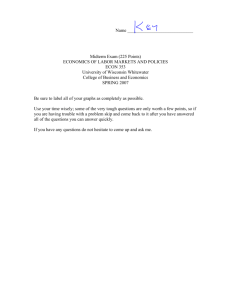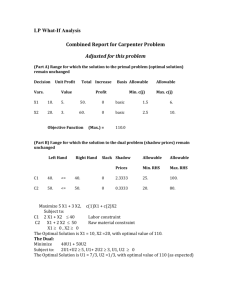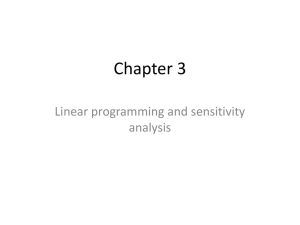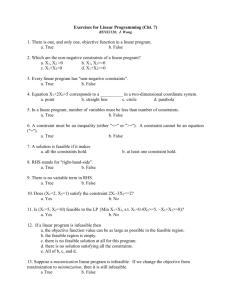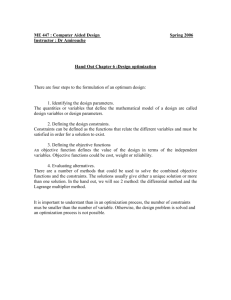Week 5 Seminar Questions
advertisement
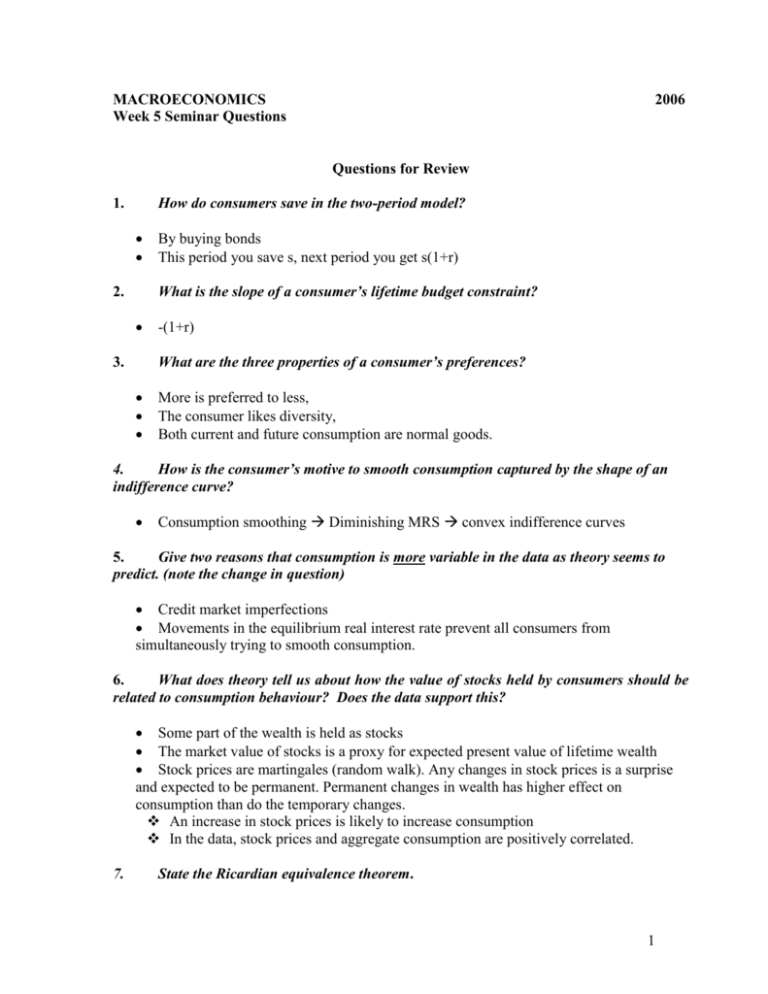
MACROECONOMICS Week 5 Seminar Questions 2006 Questions for Review 1. How do consumers save in the two-period model? By buying bonds This period you save s, next period you get s(1+r) What is the slope of a consumer’s lifetime budget constraint? 2. -(1+r) What are the three properties of a consumer’s preferences? 3. More is preferred to less, The consumer likes diversity, Both current and future consumption are normal goods. 4. How is the consumer’s motive to smooth consumption captured by the shape of an indifference curve? Consumption smoothing Diminishing MRS convex indifference curves 5. Give two reasons that consumption is more variable in the data as theory seems to predict. (note the change in question) Credit market imperfections Movements in the equilibrium real interest rate prevent all consumers from simultaneously trying to smooth consumption. 6. What does theory tell us about how the value of stocks held by consumers should be related to consumption behaviour? Does the data support this? Some part of the wealth is held as stocks The market value of stocks is a proxy for expected present value of lifetime wealth Stock prices are martingales (random walk). Any changes in stock prices is a surprise and expected to be permanent. Permanent changes in wealth has higher effect on consumption than do the temporary changes. An increase in stock prices is likely to increase consumption In the data, stock prices and aggregate consumption are positively correlated. 7. State the Ricardian equivalence theorem. 1 Holding current and future government spending fixed, a change in the timing of taxation has no effect on the equilibrium interest rate, and no effect on any consumer’s choice of current and future consumption. Problems 1. A consumer’s income in the current period is y = 100, and income in the future period is y = 120. He or she pays lump-sum taxes t = 20 in the current period and t = 10 in the future period. The real interest rate is 0.1, or 10% per period. Determine the consumer’s lifetime wealth. a. Lifetime budget constraint (y - t ) w=y-t+ =100-20+(120-10)/1.1=180 1 r b. Suppose that current and future consumption are perfect complements for the consumer and that he or she always wants to have equal consumption in the current and future periods. Draw the consumer’s indifference curves. c’ c=c’ I1 I2 Perfect complements Consume in fixed proportions c c. Determine what the consumer’s optimal first- and second-period consumption are, and what optimal saving is, and show this in a diagram with the consumer’s budget constraint and indifference curves. Is the consumer a lender or a borrower? c’ c=c’ c=c’ I1 I2 c c+ = c+0.91c’ = 180 c=c’=94.2 1 r 110 s=y-t-c = 80-94.2 = -14.2 c consumer is a borrower 80 2 2. Assume a consumer who has current-period income y = 200, future-period income y = 150, current and future taxes t = 40 and t = 50, respectively, and faces a market real interest rate of r = 0.05, or 5% per period. The consumer would like to consume equal amounts in both periods; that is, he or she would like to set c1 = c2, if possible. However, this consumer is faced with a credit market imperfection, in that he or she cannot borrow at all – that is, s 0. a. Show the consumer’s lifetime budget constraint and indifference curves in a diagram. c+ c = 200-40 + 150 - 50 1.05 1.05 c + 0.95 c’ = 255.2 E1 (160,100) initial endowment point BE1D initial budget constraint a kink at E1 because the consumer cannot borrow, and therefore cannot consume more than 160 (which is y-t) in the first period. b. Calculate his or her optimal current-period and future-period consumption, and optimal saving, and show this in your diagram. c=c’ , c + 0.95 c’ = 255.2 c=c’=130.7 and s=y-t-c s= 160-130.7=29.3 In this case, the fact that the consumer cannot borrow does not matter for the consumer’s choice, as the consumer decides to be a lender. c. Suppose that everything remains unchanged, except that now t = 20, and t = 71. Calculate the effects on current and future consumption and optimal saving, and show this in your diagram. c + c = 200-20 + 150 - 71 1.05 c + 0.95 c’ = 255.2 1.05 3 Consumer’s lifetime wealth remains unchanged at 255.2 However, the budget constraint shifts to BE2F, The new endowment point is E2 = (180,79). This change does not matter for the consumer again because he chooses to be a lender. Consumption is still c=c’ , c + 0.95 c’ = 255.2 c=c’=130.7 But now savings is s=y-t-c=200-20- 130.7 = 49.3 d. Now, suppose alternatively that y = 100. Repeat parts (a)-(c), and explain any differences. c+ c = 100-40 + 150 - 50 1.05 1.05 c + 0.95 c’ = 155.2 New the budget constraint is AE1D When the consumer chooses the point on her budget constraint which is on the highest indifference curve, any point on the line segment BE1 will do. Let her choose the endowment point E1 where c =60 and c’ = 100. s = 0 The consumer is credit-constrained( she would like to borrow, but she cannot) When taxes change The budget constraint shifts to AE2G, The endowment point is E2 = (80,79). Now the consumer can choose c = c’ on the new budget constraint: c + 0.95 c’ = 155.2 and c=c’ c=c’=79.5 s=y-t-c=100-20-79.5=0.5 Note that the rise in c is 79.5-60=19.5 is very close to the tax cut (40-20=20) But there is no change in lifetime wealth, 155.2. The budget constraint for the consumer is relaxed. For tax cuts that leave lifetime wealth unchanged, the current consumption will Remain unchanged for lenders Increase for credit constrained consumers 3. Suppose in our two-period model of the economy that the government, instead of borrowing in the current period, runs a government loan program. That is, loans are made to consumers at the market real interest rate r, with the aggregate quantity of loans made in period 1 denoted by L. Government loans are financed by lump-sum taxes on consumers in the current period, and we will assume that government spending is zero in the current and future periods. In the 4 future period, when the government loans are repaid by consumers, the government rebates this amount as lump-sum transfers (negative taxes) to consumers. a. Write down the government’s current-period budget constraint and its future-period budget constraint. No government spending in either period. In the first period, the government must collect lump-sum taxes so that T = L. In the second-period, a lump-sum rebate is given: T’ =-(1 + r)L b. Determine the present-value budget constraint of the government. T+ T' 1 r =0 c. Write down the lifetime budget constraint of a consumer. s=y+l-t-c c’=(1+r)(s+y’-t’-l) where l represents the size of the loan that the individual consumer takes from the loan program. c+ c y' t' =y+ -t1 r 1 r 1 r =y+ 1 y' - T T ' 1 r n 1 r n=population d. Show that the size of the government loan program (i.e. the quantity L) has no effect on current consumption or future consumption for each individual consumer, and that there is no effect on the equilibrium real interest rate. Explain this result. The size, L, of the loan program, does not change the fact that the present value of tax collections must equal zero. 5



